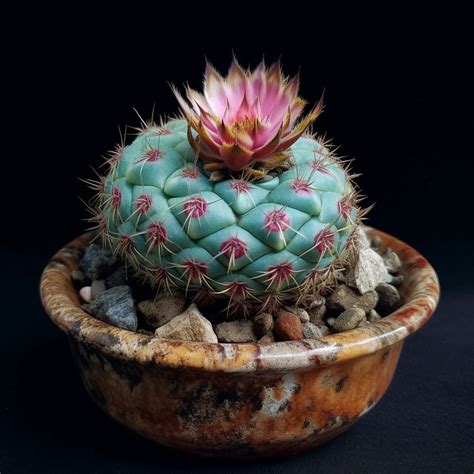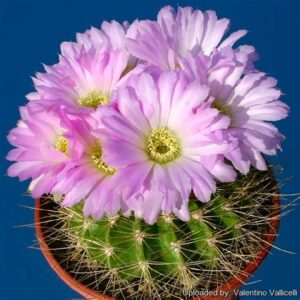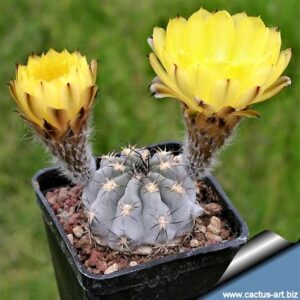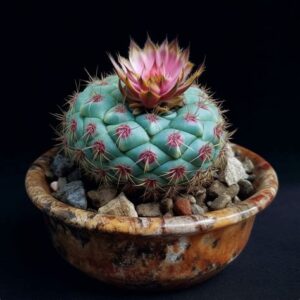Acanthocalycium spiniflorus, a visually striking species of cactus, captivates enthusiasts and casual plant admirers alike. Originating from the arid landscapes of South America, particularly Argentina, this cactus is known not merely for its radiant blooms but also for its intriguing morphology and resilience. Growing Acanthocalycium spiniflorus can be an immensely rewarding experience; however, understanding its nuanced needs is crucial for optimal care and long-term health. This article delves into the essential aspects of growing and caring for this remarkable species, illuminating the practices that lead to success in cultivating its unique beauty.
Acanthocalycium spiniflorus is distinguished by its globose to cylindrical shape, often adorned with prominent tubercles and spines that intertwine to form a thicket of protection. The flowers, which emerge from the apex of the plant, are typically vibrant yellow or orange, adding an eye-catching dimension to its overall aesthetic. As you delve into the world of Acanthocalycium spiniflorus, it becomes evident that proper care hinges on replicating its native habitat and understanding its intrinsic needs.
Understanding the native environment of Acanthocalycium spiniflorus is paramount when considering its care. Generally speaking, this species thrives in semiarid regions characterized by well-draining soils, intense sunlight, and fluctuating temperatures. These elements form the foundation from which effective cultivation strategies can be devised. So, what exactly does Acanthocalycium spiniflorus require in terms of care and growing conditions?
Soil Selection: A Foundation for Success
The substrate you choose plays an instrumental role in the overall well-being of Acanthocalycium spiniflorus. A well-draining soil mix is essential to mimic the cactus’s natural habitat, preventing root rot and promoting robust growth. A blend consisting of potting soil, perlite, and coarse sand is commonly recommended. This mixture not only ensures proper drainage but also provides adequate aeration for the roots, which are particularly sensitive to excessive moisture. Moreover, incorporating organic matter like pine bark can enhance nutrient retention without compromising aeration, a delicate balance crucial for the health of this cactus.
Watering Protocol: Striking the Right Balance
Watering Acanthocalycium spiniflorus is perhaps one of the most critical aspects of its care regime. This cactus adheres to a cyclical watering pattern, which is contingent on the season. During the growing season, typically from spring to early autumn, the plant should be watered thoroughly, allowing the excess to drain from the pot. It is advisable to ensure that the substrate dries out between watering sessions to prevent root complications.
In contrast, during the dormant winter months, water should be significantly reduced. Acanthocalycium spiniflorus does not tolerate cold, soggy conditions; hence, infrequent watering during this period will help prevent desiccation while also safeguarding against excessive moisture. Observing soil moisture levels is invaluable; a moisture meter can serve as an excellent tool in determining when it is appropriate to water.
Light Requirements: The Quest for Sunlight
Light is an essential factor influencing the growth and health of Acanthocalycium spiniflorus. This cactus flourishes in bright, direct sunlight, benefiting significantly from exposure to full sun. Ideally, an east or south-facing window will provide the best conditions indoors. For outdoor cultivation, placing the cactus in a location that receives at least six hours of direct sunlight daily will yield optimal growth and flowering. However, care should be taken to acclimate the plant to full sunshine gradually, as sudden exposure may lead to sunburn, characterized by brown, shriveled patches on the surface.
Temperature Tolerance: Keeping it Cozy
Acanthocalycium spiniflorus is relatively adaptable, yet it possesses a distinct preference for warmth. It thrives in temperatures ranging from 70°F to 90°F (21°C to 32°C) during the growing season. Conversely, during its dormant phase, it can tolerate cooler conditions but should ideally not be exposed to temperatures below 50°F (10°C). Protecting the cactus from frost and prolonged exposure to chilly drafts is essential, as this can damage its core integrity. Utilizing a temperature-controlled environment or bringing the cactus indoors during frigid months can help ensure its vitality.
Fertilization Frequency: Boosting Nutrition
Fertilization can contribute to the flourishing growth of Acanthocalycium spiniflorus during its active month. Applying a balanced, water-soluble fertilizer at half-strength once a month can supply essential nutrients, fostering robust flowering and vibrant color. It is particularly effective to fertilize during the growing season when the plant demands increased nourishment. However, one must refrain from fertilizing in the winter months, as the plant enters dormancy and does not utilize nutrients efficiently.
Pest Management: Vigilance is Key
While Acanthocalycium spiniflorus is generally resistant to pests, vigilance is paramount to avert potential infestations. Common pests include mealybugs, spider mites, and scale insects, which can manifest as small, white cotton-like masses or webbing on the surface of the cactus. Implementing a consistent inspection routine can help catch infestations early before they escalate. Neem oil or insecticidal soap can effectively manage infestations without harming the plant. Employing these organic methods ensures a healthy and thriving Acanthocalycium spiniflorus without resorting to harsh chemicals.
Propagation Techniques: Expanding Your Collection
For devoted enthusiasts, propagating Acanthocalycium spiniflorus can be both gratifying and a practical way to expand one’s collection. The process can be accomplished through seeds or offsets. Seed propagation necessitates a well-draining propagation mix, and seeds should be sown on the surface without covering them entirely, as sufficient light is critical for germination. Maintaining a humid environment can foster the sprouting of seeds, and after several weeks, they will begin to emerge.
Alternatively, offset propagation involves removing offsets from the mother plant. It is advisable to wait until the offsets have developed established roots before planting them in their own container. This approach can yield quicker results compared to seed propagation, allowing for immediate enjoyment of more Acanthocalycium spiniflorus specimens.
Common Challenges: Tackling Troubles
Caring for Acanthocalycium spiniflorus may present challenges, particularly for novice gardeners. Overwatering and poor drainage rank among the leading causes of stress for this species. Recognizing the signs of distress, such as yellowing or mushy stems, is vital in promptly remedying the situation. Additionally, abrupt changes in the environment—for instance, relocating the cactus to a significantly brighter or darker setting—may induce shock. Transitioning the plant gradually can help mitigate such risks, ensuring a smoother adaptation.
In Conclusion: The Allure of Acanthocalycium Spiniflorus
Acanthocalycium spiniflorus is more than just a beautiful cactus; it embodies a captivating story of adaptation and survival in challenging environments. Its vibrant blooms and unique structure serve as a testament to nature’s ingenuity. Through proper care, attention to its specific needs, and a willingness to learn from any challenges faced, one can cultivate a thriving Acanthocalycium spiniflorus—a living piece of the arid beauty from which it hails.
As one immerses oneself in the journey of growing this remarkable cactus, the rewards unfold not just in the form of lush growth and stunning flowers, but in the deeper appreciation for the resilience of nature, inviting participation in a timeless dialogue between plant and caretaker.





Leave a Comment